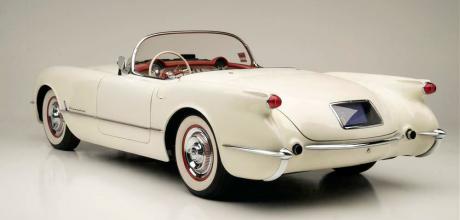First production car with a fibreglass body 1953 Chevrolet Corvette C1
When you think of motoring in 1950’s America, it’s likely that lashings of chrome, tail fins and bodywork for miles will come to mind. It’s fair to assume lightweight materials won’t feature anywhere on the list of all of the things that make up mid-20th century Americana.
THE INNOVATORS
The cars we drive today were influenced by these pioneers
Yet, in 1953, Chevrolet would literally break the mould by producing the first-ever production-series car with a fibreglass construction. In the wake of World War II, General Motors’ famed head of styling, Harley Earl, noted a peculiar shift in the tastes of younger consumers. Folks who had served in the armed forces in Europe – during World War II and on its periphery with the onset of the Cold War – had acquired a penchant for compact two-seater sportscars from the likes of MG, Jaguar, Healey-Fraser and Alfa Romeo, and were bringing these distinctive cars stateside in increasing numbers. Knowing that GM lacked anything of the sort in its stable and keen to catch onto this trend, Earl and his team produced a hand-built two-seater dubbed EX-122 Prototype, which would be showcased at GM’s extravagant Motorama Expo in January of 1953.
Interest in this precursor to the Corvette (named after the swift-moving warship and no doubt a nod to the GIs who’d started this two-seater sportscar craze) was such that GM decided to build a small production run of the car on a very tight budget. The proviso was that the car be built from off-the-shelf parts and feature the 3,85-litre Blue Flame inline-six engine used in many of the firm’s passenger vehicles at the time.
The need to keep weight in check so as not to overly tax this modestly powered engine and a means to circumvent the call for expensive sheet metal-stamping dies for such a low-volume product saw General Motors turn to an outside supplier – the Molded Fibreglass Company – to produce the Corvette’s compact, curvaceous shell. The contract was awarded in April of ’1953 with a delivery date set for June… all of this from a firm that had no experience building car bodies.
It would prove one of the most challenging automotive production runs. Exacting tests had to be carried out to see how many layers of material were required to construct both the body and tub components. Resin and plastic hardener ratios had to be determined by trial and error and the quality of paint finishes on this material – relatively unknown to automotive manufacturing at the time – was something of a gamble. Even the “chop gun” production method – by which layers of resin and fibreglass matting were blown layer by layer into moulds for each part – was a time-consuming precursor to the 3D printing methods used to build complex components today. Needless to say, the results were variable but the die was struck (no pun intended) and the Corvette’s popularity – along with the adoption of developments in lightweight materials and innovative construction methods through each ensuing generation of what’s seen as the all-American sportscar – has endured and helped to bolster the increased use of composites and other weight-saving materials in many of the cars we see today.
THEY ALSO PAVED THE WAY
- 1914 DODGE 30-35 The 30-35 would become one of the first production-seriesmodels to feature an all-steel body construction that allowed for greater strength and shaping options than the wood-bodied cars before it.
- 1990 JAGUAR XJR-15 The Tom Walkinshaw Racing-designed successor to the radical XJ220 was a V12-engined racecar for the road that also became the first road-going production car entirely made from lightweight-but-strong carbon fibre.
- 1994 AUDI A8 Some may argue that Ettore Bugatti’s 1910model 10 was the first aluminium-bodied car in the world, but the A8 was the first production series car to feature an aluminium-spaceframe that helped offset the weight of its AWD system.
- 2014 LOCAL MOTORS STRATI Comical as it may look, the Strati EV holds a place in automotive history as the first 3D-printed road car. Its composite shell took 44 hours to print and three further days of milling to create the final product


